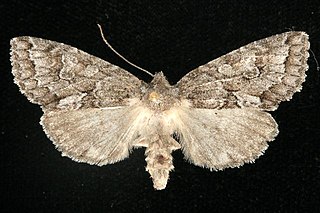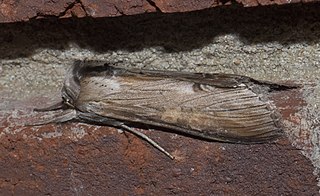Properigea perolivalis is a species of cutworm or dart moth in the family Noctuidae. It was first described by William Barnes and James Halliday McDunnough in 1912 and it is found in North America.
Nocloa cordova is a species of moth in the family Noctuidae. It was first described by William Barnes in 1907 and it is found in North America.
Dasychira meridionalis, the southern tussock moth, is a species of tussock moth in the family Erebidae. It was first described by William Barnes and James Halliday McDunnough in 1913 and it is found in North America.
Properigea costa, the barrens moth, is a species of cutworm or dart moth in the family Noctuidae. It was first described by William Barnes and Foster Hendrickson Benjamin in 1923 and it is found in North America.
Scotogramma submarina is a species of cutworm or dart moth in the family Noctuidae first described by Augustus Radcliffe Grote in 1883. It is found in North America.
Lythrodes tripuncta is a species of moth in the family Noctuidae. It was first described by William Barnes and James Halliday McDunnough in 1911 and it is found in North America.
Lineostriastiria hutsoni is a species of owlet moth in the family Noctuidae. It is found in North America.
Oligia rampartensis is a species of cutworm or dart moth in the family Noctuidae first described by William Barnes and Foster Hendrickson Benjamin in 1923. It is found in North America.
Mesapamea arbora is a species of cutworm or dart moth in the family Noctuidae first described by William Barnes and James Halliday McDunnough in 1912. It is found in North America.
Unciella primula is a species of moth in the family Noctuidae. It was first described by William Barnes and James Halliday McDunnough in 1918 and it is found in North America.
Euxoa olivalis is a species of cutworm or dart moth in the family Noctuidae. It is found in North America.

Lithophane antennata, known generally as the ashen pinion or green fruitworm, is a species of cutworm or dart moth in the family Noctuidae. It is found in North America.
Xylomoia chagnoni, the Chang borer moth, is a species of cutworm or dart moth in the family Noctuidae. It was first described by William Barnes and James Halliday McDunnough in 1917 and it is found in North America.
Alypiodes geronimo is a species of owlet moth in the family Noctuidae first described by William Barnes in 1900. It is found in North America.
Bleptina minimalis, the small owlet moth, is a species of litter moth in the family Erebidae. It was first described by William Barnes and James Halliday McDunnough in 1812 and it is found in North America.
Anarta alta is a species of cutworm or dart moth in the family Noctuidae first described by William Barnes and Foster Hendrickson Benjamin in 1924. It is found in North America.

Xylotype arcadia, the acadian sallow, is a species of cutworm or dart moth in the family Noctuidae. It was first described by William Barnes and Foster Hendrickson Benjamin in 1922 and it is found in North America.

Cucullia asteroides, known generally as the goldenrod hooded owlet or asteroid moth, is a species of owlet moth in the family Noctuidae. It is found in North America.
Cryphia sarepta is a species of moth in the family Noctuidae. It was first described by William Barnes in 1907 and it is found in North America.
Plagiomimicus ochoa is a species of moth in the family Noctuidae. It was first described by William Barnes in 1904 and it is found in North America.


